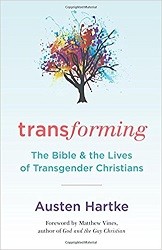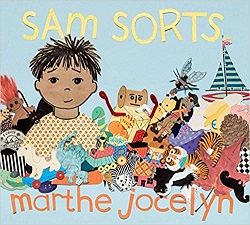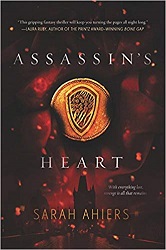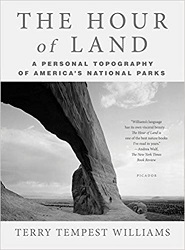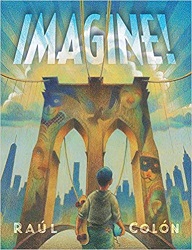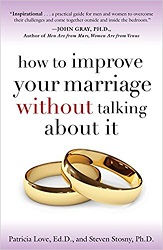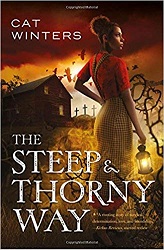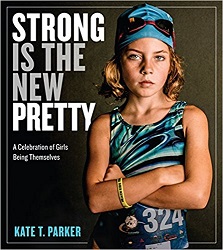Review of Transforming, by Austen Hartke
The Bible & the Lives of Transgender Christians
by Austen Hartke
Westminster John Knox Press, 2018. 198 pages.
Starred Review
I picked this book up from the library, and the very next day was glad I did, having a reason to defend transgender people to some well-meaning Christian friends. My own oldest child is a transgender woman. I’ve seen for myself this isn’t some kind of delusional temporary whim. I’m also in a Facebook group for mothers of transgender children. I’ve heard many sad stories of what happens when a church family rejects a transgender person and the harm it causes their entire families. At the same time, I’ve read happy stories of what happens when people transition with love and acceptance from their faith communities.
This book is written by a transgender pastor. He brings in the voices of many other transgender people. He talks about the good it does transgender people when their churches accept them – but also the good it brings to churches when they embrace their transgender members.
There’s background at the front. There are personal stories. I’m not going to repeat every argument why it is not biblical to reject transgender people or to require that gender dysphoria is the one medical condition that should not receive medical treatment of any kind.
I knew that the Bible does not speak against being transgender. But I hadn’t realized how much there is specifically for those who don’t fit gender norms.
I was especially touched by the author’s description of how he found life in the passage Isaiah 56:3-8. I’ll copy a little bit of that here:
“Do not let the foreigner joined to the Lord say,
“The Lord will surely separate me from his people”;
and do not let the eunuch say,
“I am just a dry tree.”
For thus says the Lord:
To the eunuchs who keep my Sabbaths,
who choose the things that please me
and hold fast to my covenant,
I will give, in my house and within my walls,
a monument and a name
better than sons and daughters;
I will give them an everlasting name
that shall not be cut off….
for my house shall be called a house of prayer
for all peoples.
Thus says the Lord God,
who gathers the outcasts of Israel,
I will gather others to them
besides those already gathered.”I was floored. I could swear I had never heard these verses before in my life, despite having read through the book of Isaiah for a class only the year before. I felt an immediate connection to the eunuch and the foreigner. Their fear of separation, fear of being forgotten, fear of being kept out of God’s family – all based on identities as unchosen as the place of their birth and as intrinsic as the shape of their body. Their fears were my fears too. Yet here was God, speaking through the prophet Isaiah, quieting those fears and promising an unequivocal welcome.
He goes on to explain why eunuchs, especially after the Babylonian exile, were in a place similar to transgender people today. And yet God gives them in this passage a name, legacy, family, acceptance, and blessing.
And of course there is more about eunuchs in the Bible. Jesus talked about them, and the evangelist Philip was sent by the Holy Spirit specifically to the Ethiopian eunuch. I like this paragraph:
Whether you believe Jesus was advocating for castration, for celibacy, or for something else entirely in Matthew 19, the fact that he uses eunuchs as a positive example is huge. It means that Jesus knew about people who fell outside the boundaries of sex and gender, and that he did not see them as broken or as morally corrupt. He saw them as people with a variety of experiences and as people with something important to teach the world about God’s kingdom.
There’s lots more “apologetics” – defending that transgender people belong in the church and should not be excluded. But he moves on to explain why this is important:
This is when trans Christians experience life in abundance – when they are welcomed into community; when they are loved for all of who they are; when their differences are respected; when they know they can count on their community to help with their daily human needs; and when they feel safe enough to drop their defenses in order to take on Jesus’ gentle yoke of discipleship. That may sound like a lot to ask of a church, but in reality these are commitments we try to make to the cisgender members of our communities. So why not include trans folks? After all, if the life Jesus promises is abundant, surely there’s enough to go around!
In the concluding chapter, he looks at the parable of the lost sheep.
But what if we imagined this story a different way? What if the lost sheep didn’t wander away from the safety and goodness of the shepherd? What if it was just trying to escape the cruelty of the flock? Sheep will occasionally pick out a flock member who doesn’t fit in – maybe because of an injury or a strange marking – and they’ll chase that individual away. There are times when I think Christians need to see ourselves more in the ninety-nine sheep who stayed put, and ask ourselves if we may have been part of the reason that the lost sheep got lost in the first place.
And his appeal reminds us that we as a church have much to gain by being more welcoming:
But what’s at stake for Jesus in this situation isn’t just that one single lost sheep, and it’s not just the ninety-nine back home. It’s the integrity of the flock as a whole. Saving just the main group or just the individual wouldn’t do any good, because the flock is more than just the sum of its parts. When Jesus goes after that lost sheep, what he’s telling the flock – what he’s telling us – is that we’re not complete without each other.
In this book, transgender Christians have shared their stories and the ways that Scripture, faith, and gender identity interact in their lives. I hope you’ve been able to read these stories and come to the same conclusion the shepherd did: that our faith communities and churches aren’t complete without trans folks and their experiences.
At the messy, lovable, chaotic potluck that is life in the church, transgender Christians have a lot to bring to the table. We can help the church see Scripture through different lenses; we can help other Christians understand their own gender identities; we can help to break down barriers created by sexism and misogyny; we can remind people of the diversity of God’s creation, and of God’s unlimited nature; we can stand in the gaps and bridge middle spaces where others may be uncomfortable or uninformed; we can help make connections between the sacred and the secular, making the church more relevant for the world, and we can provoke people into asking questions about themselves and about God that they may never have thought to ask before. And that’s all while most churches still don’t affirm our existence as Christians! Imagine what we could do if we worked together!
There’s a lot more in this book. I hope that reading it will open many hearts. Let’s follow the teaching of Scripture and welcome all into our churches, including those who were once outcasts.
Find this review on Sonderbooks at: www.sonderbooks.com/Nonfiction/transforming.html
Disclosure: I am an Amazon Affiliate, and will earn a small percentage if you order a book on Amazon after clicking through from my site.
Source: This review is based on a library book from Fairfax County Public Library.
Disclaimer: I am a professional librarian, but I maintain my website and blogs on my own time. The views expressed are solely my own, and in no way represent the official views of my employer or of any committee or group of which I am part.
What did you think of this book?
